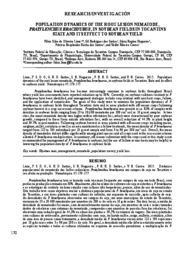Population dynamics of the root lesion nematode, Pratylenchus brachyurus, in soybean fields in Tocantins state and its effect to soybean yield.
Population dynamics of the root lesion nematode, Pratylenchus brachyurus, in soybean fields in Tocantins state and its effect to soybean yield.
Author(s): LIMA, F. S. de O.; SANTOS, G. R. dos; NOGUEIRA, S. R.; SANTOS, P. R. R. dos; CORREA, V. R.
Summary: Pratylenchus brachyurus has become increasingly common in soybean fields throughout Brazil where yield loss assessments have reported reduction up to 30%. Currently, no soybean cultivars resistant to P. brachyurus have been identified, and management strategies include crop rotation with non-host crops, fallow, and the application of nematicides. The goals of this study were to examine the population dynamics of P. brachyurus in soybean fields throughout Tocantins state and in areas planted with off-season crops following soybean harvest in a crop succession scheme. Pratylenchus brachyurus was present in ca. 82% of samples with densities in soybean fields ranging from 23 to 20,400 nematodes per 200 cm3 soil or 10 g root samples. In two sites, the mean nematode density was higher within infestation foci, which were characterized by poor soybean growth, compared to those from outside infestation foci, with an overall reduction of 44.3% in plant height and 39.7% in pod numbers. Following soybean harvest in areas planted with off-season crops including maize, sorghum, millet, crotalaria as well as an area maintained as a fallow treatment, the mean density of P. brachyurus ranged from 122 to 504 individuals per 10 g root sample and from 3 to 96 per 200 cm3 soil. Overall, the mean density of nematodes did not differ significantly among plant species and all crops used in the succession scheme allowed P. brachyurus multiplication. In summary, off-season cultivation with the crops used in this study is not recommended for management of P. brachyurus in soybean, but the use of fallow or non-hosts may be helpful in lowering the population density of P. brachyurus in soybean fields.
Publication year: 2015
Types of publication: Journal article
Unit: Embrapa Acre
Observation
Some of Embrapa's publications are published as ePub files. To read them, use or download one of the following free software options to your computer or mobile device. Android: Google Play Books; IOS: iBooks; Windows and Linux: Calibre.
Access other publications
Access the Agricultural Research Database (BDPA) to consult Embrapa's full library collection and records.
Visit Embrapa Bookstore to purchase books and other publications sold by Embrapa.

